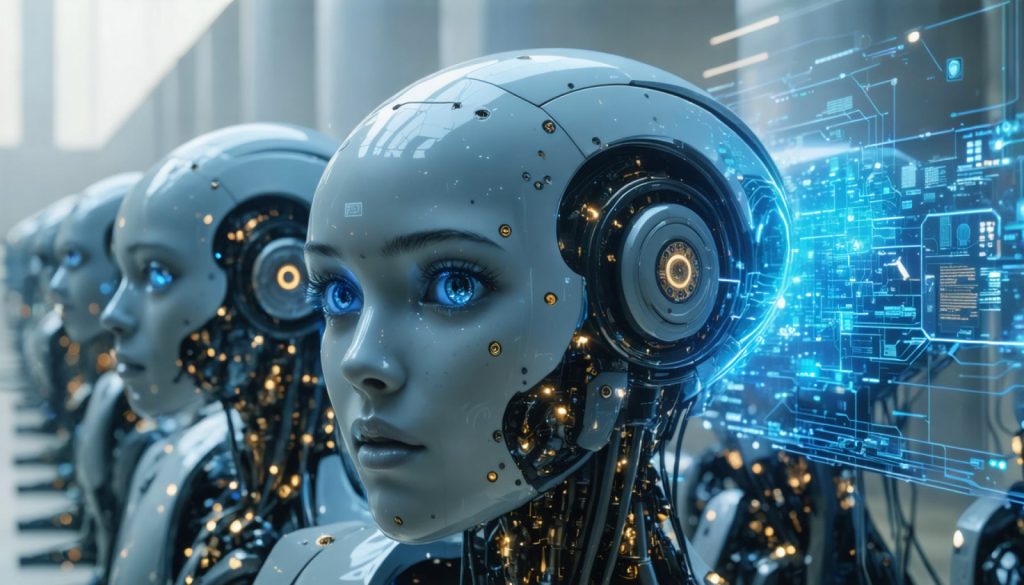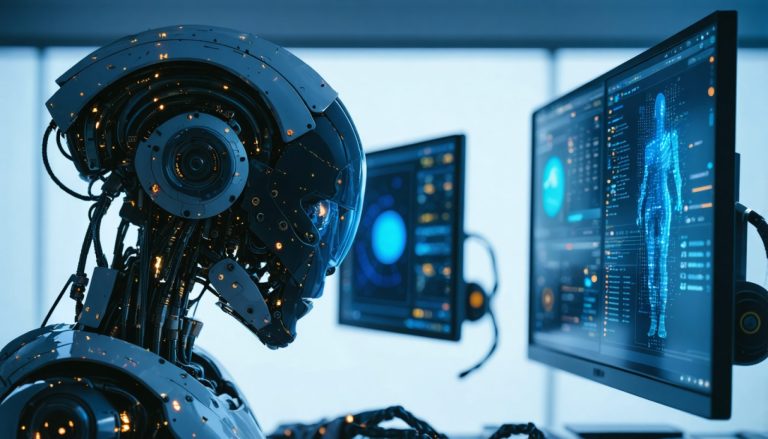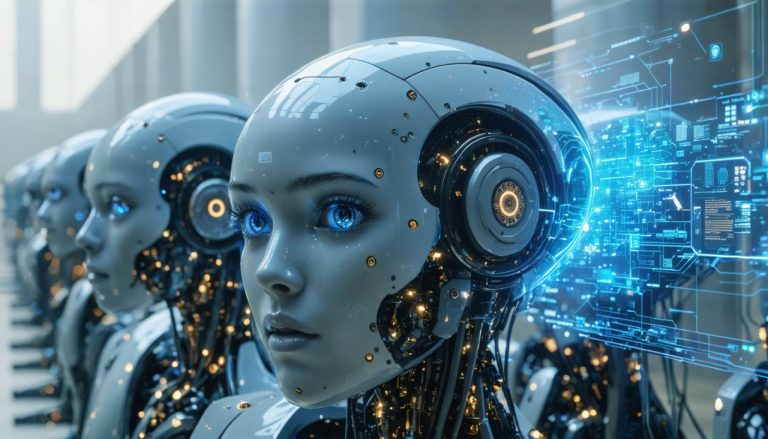
- AI could add $500 billion to India’s GDP by 2035, reshaping its economy and industries.
- AI offers transformative benefits, enabling remote healthcare access, optimizing agriculture, and personalizing education.
- The rise of AI comes with challenges, risking the displacement of over 200 million jobs by 2030, particularly in clerical and IT sectors.
- Early adoption of AI technology can boost prosperity, but may also widen global inequalities.
- Strategies for India include enhancing computing infrastructure, promoting research, and reskilling the workforce annually.
- Regulation will be key to balancing progress with consumer protection and privacy.
- India faces a critical choice: harness AI’s potential or risk being overtaken by its disruptions.
A quiet revolution is brewing in the heart of India, with the potential to redefine its economy, reshape its industries, and alter its global standing. Artificial intelligence (AI), a technology once confined to the peripheries of experimental research, is now steering the course of the future, promising an economic infusion of nearly $500 billion to India’s GDP by 2035. This is not a distant prospect but a tangible opportunity – and, perhaps, a lurking threat.
Imagine a nation where AI-driven diagnostics reach the most remote healthcare outposts, bridging the yawning gap in doctor availability. Picture smart algorithms guiding smallholder farmers, optimizing crop yield while cushioning against the whims of climate. Envision personalized education systems that adapt to individual learning needs, lifting the veil of inequality in educational access. Such are the landscapes AI promises to paint in this vast and vibrant country.
Yet, beneath the surface of these digital dawns lies a shadow. For every task AI streamlines, for every nuance it learns to understand, a human job stands vulnerable. By 2030, automation may eclipse nearly 40% of work hours across India. This technological tide threatens to displace over 200 million jobs, particularly enlisting its impact on roles traditionally considered secure: clerical, administrative, and those seated at the heart of the IT services industry. As machines learn and labor, millions face the specter of obsolescence.
Globally, the AI landscape is a treacherous terrain. Early adopters of AI technology are sprinting towards prosperity at a pace 1.5–3% faster annually than their slower counterparts, which risks compounding existing global inequalities. Moreover, as manufacturers lever AI and robotics to re-shore production, India’s cost calculus – its labor advantage – faces erosion.
To harness AI’s prowess without being subsumed by its disruption, India must pivot strategically. The blueprint for a resilient future is comprehensive: scale computing infrastructures, catalyze research innovations, and embark on reskilling missions for millions annually. A delicate balance of intelligent regulation must weave privacy with progress, ensuring the consumer is both protected and empowered.
The AI era promises a dichotomy of change: a beacon of unprecedented opportunity and a signal fire of caution. India stands at this decisive juncture, where the steps taken today will craft the narrative of tomorrow. Inaction is not an option; the future waits for no one.
AI in India: Navigating the Promises and Pitfalls of an Emerging Technological Age
The Transformative Potential of AI in India
India stands on the cusp of a technological revolution, with artificial intelligence (AI) poised to significantly impact its economy, society, and global position. By 2035, AI is projected to contribute an astonishing $500 billion to India’s GDP. The integration of AI across various sectors, such as healthcare, agriculture, and education, promises not only increased efficiency but also transformative outcomes for the nation’s populous regions.
AI’s Role in Key Sectors
1. Healthcare Innovations: The deployment of AI-driven diagnostics in remote areas can drastically improve healthcare accessibility. By overcoming the barrier of limited healthcare professionals, AI tools can offer preliminary assessments and monitor vital health statistics, allowing timely intervention. This can particularly benefit rural populations that often face long distances to medical facilities.
2. Agricultural Advancements: Smallholder farmers can leverage AI for predictive analytics, helping optimize planting schedules and crop management. AI’s capability to integrate weather patterns and soil conditions contributes to sustainable agricultural practices, potentially increasing yields and reducing dependency on erratic climate conditions.
3. Personalized Education: AI can tailor learning experiences to suit individual needs, thereby addressing the disparities in educational resources across urban and rural areas. Adaptive learning platforms can help bridge the gap created by uneven teacher distribution and improve student outcomes nationwide.
Challenges and Criticisms: The Darker Side of AI Deployment
While AI offers numerous benefits, it also presents significant challenges:
1. Job Displacement: Nearly 40% of work hours in India may be automated by 2030, potentially displacing over 200 million workers. Roles in clerical, administrative, and IT sectors are particularly susceptible. The rapid pace of technological advancement underscores the urgency for these sectors to innovate and diversify skill sets.
2. Inequality and Global Dynamics: Early AI adoption can exacerbate existing inequalities, both domestically and globally. Economies embracing AI technology are progressing at a faster rate than those lagging behind, thus potentially widening the socioeconomic gap.
Strategies for Mitigation and Empowerment
India’s strategic approach should focus on comprehensive measures to mitigate potential AI-induced disruptions:
1. Reskilling Initiatives: Implement large-scale reskilling programs to equip the workforce with skills that complement AI, rather than compete with it. Partnerships between industry and educational institutions can facilitate these programs’ rollout.
2. Research and Infrastructure Expansion: Investing in AI research and development, coupled with a robust computing infrastructure, will catalyze innovation while maintaining competitive advantage.
3. Balancing Privacy and Innovation: As AI technologies evolve, ensuring data privacy without stifling innovation is crucial. Intelligent regulation is needed to protect consumers and maintain India’s competitive edge.
Real-World Use Cases and Trends
AI’s practical implementation within India is already underway in several innovative ways:
– Tata Consultancy Services (TCS) and other leading IT firms are integrating AI solutions to streamline operations and improve service delivery.
– India’s startups are playing a pivotal role, driving AI developments in fintech, health tech, and agritech.
Pros and Cons of AI Integration
– Pros: Enhanced productivity, economic growth, improved societal welfare through AI-driven public services.
– Cons: Job displacement, increased inequality, challenges in regulatory and ethical governance.
Actionable Recommendations
1. Engage in Continuous Learning: Embrace online courses and workshops that focus on AI-related skills to stay relevant in a shifting job market.
2. Advocate for Equitable Policies: Encourage policies that distribute AI’s benefits widely across different socioeconomic strata.
Conclusion
AI is more than a technological tool; it is an agent of profound societal change. As India navigates this new digital epoch, its success will heavily depend on thoughtful integration and proactive measures to harness AI’s benefits while mitigating its risks.
For more information and resources on AI developments, visit NASSCOM or Invest India.



